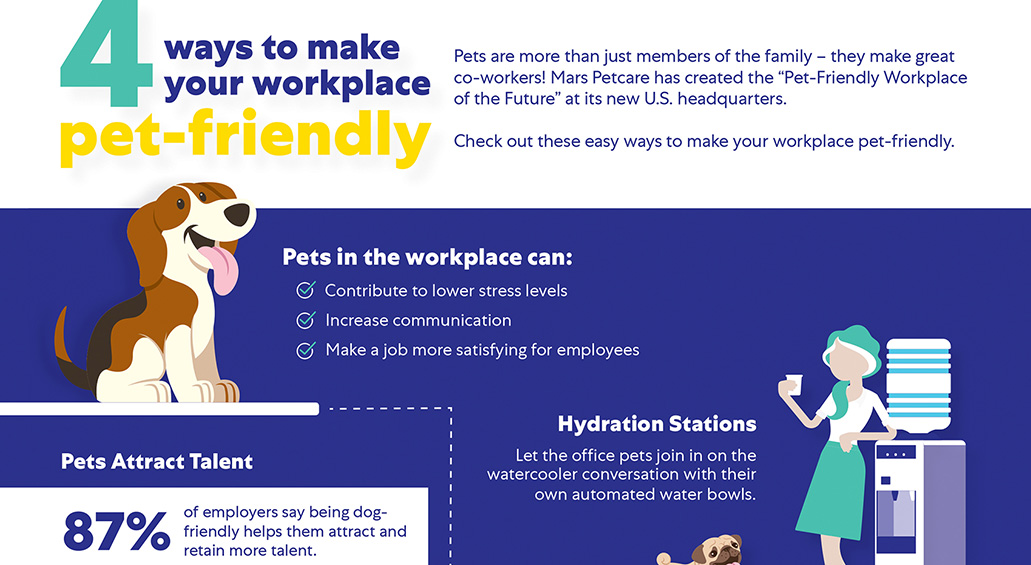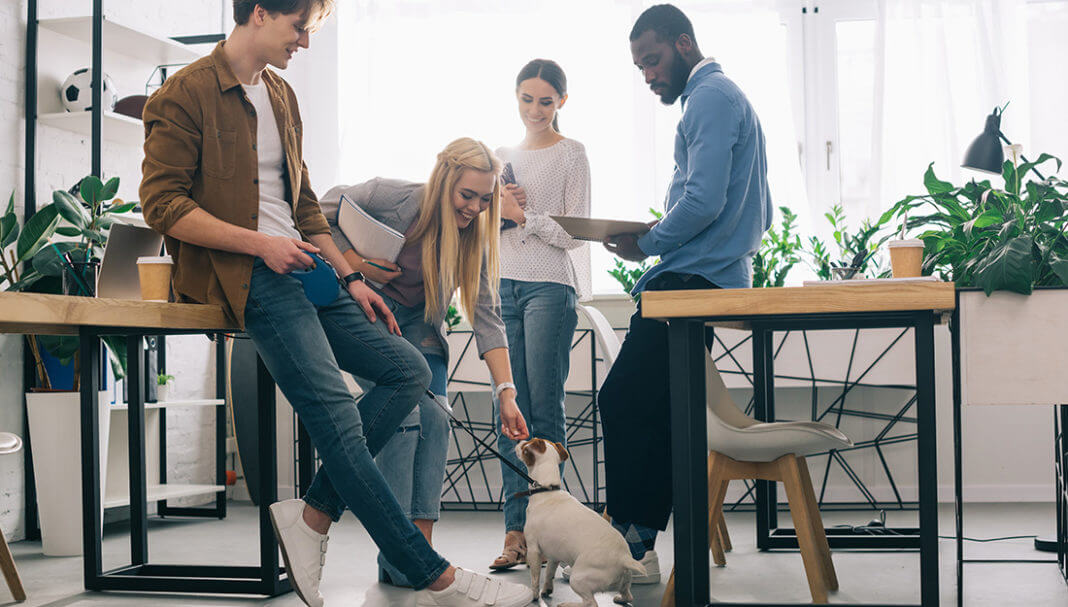Here are tips to help you understand and anticipate pet behavior when pets visit your business.
These tips focus primarily on dogs, since they’re the more common pet visitor to businesses and are more likely to enjoy social interactions in public spaces. We’ve included notes for cats as well, but they are sometimes less likely to be comfortable in public spaces, so fewer pet parents may choose to bring them into social settings.
The key with any pet is to be calm, respectful and aware of how the pet is reacting to you and to his or her situation.
Also, keep in mind that all pets are individuals. They have quirks, moods and idiosyncrasies just like we do. Just as a smiling person may not actually be happy, a dog wagging its tail may not necessarily be comfortable. Similarly, for cats, purring can be a sign of happiness, but it can also be a sign of discomfort.
Look for cues from the whole pet for a sense of how they’re feeling and always ask the pet parent before engaging with a dog or cat. Download our Happy Pet Handbook for additional insights about interpreting pet behavior.
How to greet a dog
- Always, always, always ask the dog’s owner first.
- Stand or kneel down a safe distance away; don’t invade a dog’s personal space.
- Avoid leaning over or looming above the dog; stay to the side.
- Don’t make direct eye contact; look slightly to the side.
- Avoid sudden movements.
- Let the dog approach you; don’t reach toward him or her.
- Once the dog has sniffed you, if he or she opts to stay nearby, then pet gently on the neck — petting an unfamiliar dog on the head can make him or her uncomfortable.
- If the dog is comfortable, his or her owner can tell you if there’s a special way their dog likes to be touched, for example scratching behind his or her ears.
- When finished, move slowly away, again avoiding sudden movements.
Things to avoid that could make a dog feel threatened
- Taking food away while they’re eating.
- Taking a toy away while they’re playing.
- Disturbing a dog while they’re asleep.
- Lifting or trying to pick up the dog.
- Touching the dog’s ears, feet or belly.
- Scolding the dog.
- Putting your face in the dog’s face.
- Staring at the dog.
- Leaning or looming over a dog.
- Petting on the head — always pet an unfamiliar dog on the neck or chest so they can see you coming.
Signs that a dog is confident and happy
- Soft, loose body.
- Soft, almond-shaped eyes.
- Wagging or neutral tail.
- “Smiling” face with an open or relaxed mouth.
- Eyes open but not wide or blinking frequently.
- Ears up or natural.
- Weight evenly distributed when standing.
- Offering a “play bow” — this looks like the downward dog yoga position, with front legs down and tail end up in the air. It usually means the dog wants to play with you or another dog.
Signs that a dog may be getting anxious or uncomfortable
- Licking lips when not drinking or thirsty.
- Yawning when not tired.
- Blinking rapidly.
- Stiff and/or tense body.
- Shaking or shivering when not cold.
- Skin rippling when touched.
- Increased and/or heavy breathing.
- Ears back or flat on head.
- Tail low or between legs.
- Head down or crouching.
- Fidgeting or shifting weight back and forth.
- Barking and/or growling.
- Eyes wide showing the whites of the eye; looking at you from the side.
Signs that a dog may be getting over-excited
- Pulling strongly on their leash.
- Spinning around in circles.
- Standing still with muscles twitching.
- Nipping at fingers, clothing or other items.
- Staring intently around at the room and avoiding eye contact.
- Barking rapidly or excessively.
- Holding their tail high and erect.
- Stiff and/or tense body.
- Holding their mouth tightly closed or with lips drawn back.
- Ears standing up in an alert position.
- Turning their body away from someone/something.
- Growling, barking, whimpering or whining.
Signs that two dogs may not be interacting positively together
- They stand still and/or become rigid.
- Their barking becomes guttural.
- Either of the dogs shows the anxiety signs listed above.
- Either dog lunges at the other, or they lunge at each other.
- They show their teeth, snarl or lick their lips.
- They stand up on their hind legs, face-to-face.
- One or both dogs try to hide behind their owners or get away.
- One dog pins the other on its back and won’t let it get up.
- (Dogs play-bowing to each other with their front legs generally is a sign of play, not fighting.)
Signs that a dog needs to go out for a bathroom break
- Sniffing around as if looking for something.
- Circling or otherwise being restless.
- Leaning or pulling toward the door.
- Pacing from their owner to the door and back.
- Standing in front of the door.
- Moving suddenly to a corner of the room.
- Moving suddenly to the door.
- Pawing at the door.
- Whining or whimpering.
Understanding Cats
While bringing cats into public spaces has grown in popularity, for example on a leash or in a carrier, some cat experts like International Cat Care believe that this creates stress. Cats often prefer situations that are more predictable and controllable – it’s why cats often like a cozy hiding place where they feel safe.
Like dogs, the key is for cat parents to know their cats well and know what situations will be comfortable for them. Here again, it’s critical to always talk with the cat parent before engaging with their cat. Pet parents need to read the nuances of their cats’ behavior and reactions, to ensure their wellbeing is protected and everyone around them is safe too.
Signs that a cat may be uncomfortable or feeling aggressive
- Ears turned backward, sideways or flat (like helicopter or airplane wings).
- Pupils dilated, though this can also be a sign of feeling playful.
- Tail twitching or flicking back and forth, especially with the fur standing up.
- Fur on their back standing up or twitching/rippling.
- Back arched with fur standing up (if their fur is down, they may be offering their back for you to pet).
- Whiskers fanned out and pointing forward or flattened against the side of the face.
- Hunching close to the ground or cringing, often with the tail thumping on the ground.
- Swatting with their paw when someone gets too close.
- Low-pitched meowing, growling or hissing.
Want more tips? Check out the Pets Welcome Toolkit for info about how to launch a pet-friendly business initiative that can benefit businesses, pet parents and pets.





 Your Privacy Choices
Your Privacy Choices